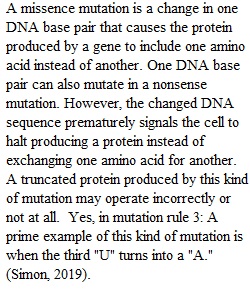


Q UNIT 5 EXPERIMENT ANSWER SHEET Please submit to the UNIT 5 Experiment SUBMISSION LINK no later than Sunday midnight. SUMMARY OF ACTIVITIES FOR UNIT 1 EXPERIMENT ASSIGNMENT • Experiment 5 Exercise 1 – Transcription and Translation • Experiment 5 Exercise 2 – Translation and Mutations • Experiment 5 Exercise 3 – Mutation Rates Experiment 5 Exercise 1: Transcription and Translation This exercise will ensure that you have a good understanding of the processes of transcription and translation. To get started, go to the following website: University of Utah. No date. Transcription and Translation https://learn.genetics.utah.edu/content/basics/txtl/ Procedure A. Watch the introduction and select a gene to proceed. B. On the next screen transcribe the give DNA strand. Table 1. Transcription of the DNA sequence (1.5 pts). Include no more than 22 nucleotides. RNA C. Once you have finished transcribing the DNA, you will then translate the RNA sequence. Follow the instructions on the screen. Table 2. Translation (1.5 pts) Only include the first six codons and amino acids. Codon Amino Acid Codon 1 Codon 2 Codon 3 Codon 4 Codon 5 Codon 6 Experiment 5 Exercise 2: Translation and Mutations Now that you know how to transcribe DNA and translate the mRNA message, let’s take a look at the different types of mutations that might disrupt this process. Review pp 186-187 in your book before beginning. In this exercise you will need to use the following website: The Concord Consortium. No date. DNA Mutation Simulation https://www.biologycorner.com/worksheets/DNA-sim.html Procedure A. Click “Edit DNA” so that you can view the original DNA sequence. B. Click “Transcribe” to generate the mRNA sequence. C. Click “Translate” to generate the amino acid sequence. D. Click “Edit DNA” to make a mutation to the DNA by changing the DNA sequence. Make note of your mutation rule. E. Repat steps B and C. Table 3. Mutation rules, mRNA sequences and amino acid sequences (10 pts). Rep Mutation Rule and Sequences E X A M P L E Mutation rule: The 4th A becomes a C Original mRNA sequence AUG CAC ACG GUG CGA GGG AGU CUG Original amino acid sequence Met (Start) - His - Thr - Val - Arg - Gly - Ser - Leu Mutated mRNA sequence AUG CAC ACG GUG CGC GGG AGU CUG Mutated amino acid sequence Met (Start) - His - Thr - Val - Arg - Gly - Ser - Leu Consequence Substitution appears to have had no effect; Arg ? Arg 1 Mutation rule: Original mRNA sequence Original amino acid sequence Mutated mRNA sequence Mutated amino acid sequence Consequence 2 Mutation rule: Original mRNA sequence Original amino acid sequence Mutated mRNA sequence Mutated amino acid sequence Consequence 3 Mutation rule: Original mRNA sequence Original amino acid sequence Mutated mRNA sequence Mutated amino acid sequence Consequence 4 Mutation rule: Original mRNA sequence Original amino acid sequence Mutated mRNA sequence Mutated amino acid sequence Consequence 5 Mutation rule: Original mRNA sequence Original amino acid sequence Mutated mRNA sequence Mutated amino acid sequence Consequence Questions 1. What is a silent mutation? Did you see any examples of this in your mutations above? If so, which mutation rule(s) generated it? Cite your sources (2 pts). 2. What is a missense mutation and how does it differ from a nonsense mutation? Did you see examples of either of these types of mutation and if so, which mutation rule(s) generated it? Cite your sources (2 pts). 3. What is a frame-shift mutation and why are they so damaging? Did you see any examples of this in your mutations above? If so, which mutation rule(s) generated it? Cite your sources (2 pts). 4. Find a genetic disorder that develops as a result of one of the types of genetic mutations we have examined in this exercise. Identify the disorder and briefly describe the mutation responsible. Cite your sources (3 pts). Experiment 5 Exercise 3: Mutation Rates We learned in our second exercise that not all mutations have an observable effect. Yet the risk of a mutation being damaging is fairly significant, so it is important to understand the probability of them occurring. In this exercise, we are going to calculate the probability of a mutational event within a gene. You are given the necessary information below to complete the calculations. Do not let them overwhelm you; this is simple math, so think things through. Assume that: • there are approximately 3,000,000,000 base pairs in the mammalian genome (genes constitute only a small portion of this total) • there are approximately 10,000 genes in the mammalian genome • a single gene averages about 10,000 base pairs in size Questions 1. Based on the assumptions above, in the mammalian genome, how many total base pairs are in all the mammalian genes? Show your math (2 pts). 2. What percentage (%) of the total genome does this represent? Show your math (2 pts). 3. What is the chance (%) that a random mutation will occur in any given gene? Show your math (2 pts). 4. Only 1 out of 3 mutations that occur in a gene result in a change to the protein structure. What is the probability that a random mutation will change the structure of a protein? Show your math (2 pts). UNIT 1 Experiment Grading Rubric Component Expectation Points Experiment 5 Exercise 1 Demonstrates an understanding of the process of transcription and translation (Table 1 and 2). 3 pts Experiment 5 Exercise 2 Correctly implements the proper mutation and transcribes the mRNA correctly (Table 3). 10 pts Demonstrates an understanding of the different types of mutations and their consequences (Questions 1-4). 9 pts Experiment 5 Exercise 3 Correctly calculates the necessary information (Questions 1-4). 8 pts TOTAL 30 pts
View Related Questions